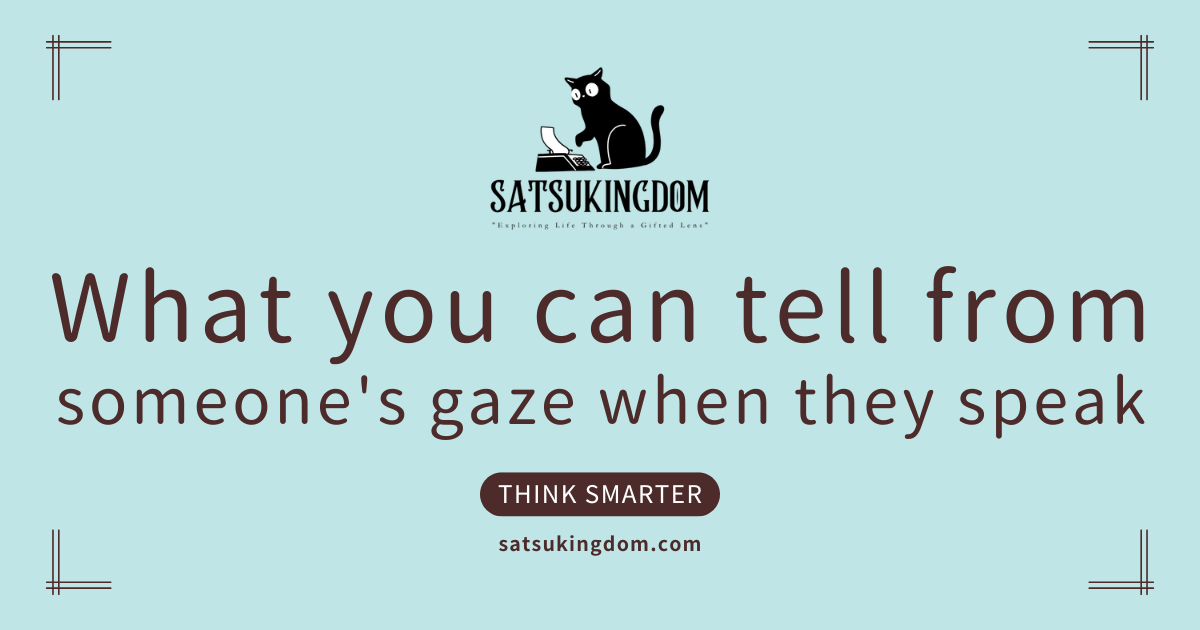This time, I’ll be discussing the direction of people’s gaze. This is a theory I encountered while working in sales. It doesn’t necessarily apply to everyone. It’s more about describing a tendency that exists.
Information obtained from eye contact
When having a conversation, look the other person in the eye.
This is something we’ve heard since childhood, isn’t it? It’s a way of showing you that we’re talking to you, and it’s very important. And that was true in everyday life as well as in sales activities. That’s how much information is contained in a person’s gaze.
I work in sales and have spoken with many people every day. During that time, I noticed something. When people are trying to remember something, I feel like many tend to look to the left. When they’re imagining something or making up a story, I feel like many tend to look to the right.
While I was vaguely keeping it in mind as my own rule of thumb, I came across a book.
The book contained the following content.
Where people direct their gaze changes depending on what information they are processing. This occurs unconsciously and is used in order to activate brain function, so individuals rarely notice it. Furthermore, this pattern may reverse depending on handedness, and it does not apply to everyone.
I was amazed to find the very things I had experienced and felt systematically organized within the pages of the book, and I read it so intently that I lost track of time.
Direction of gaze and tendency of thought
To summarize simply, the main differences appear to be as follows. Left and right are written based on a right-handed person.
- Look to the upper left: Past visual memories
Trying to recall scenes or events actually seen in the past
Example: When trying to remember “What did I eat for dinner yesterday?” - Look to the upper right: Visualizing the future
Imagining things you haven’t seen yet, things that will happen
Example: When imagining “what scenery you might see on a weekend trip” - Looking to the left: Past auditory memories
Trying to recall sounds or conversations actually heard in the past
Example: When recalling “an old friend’s voice” or “the lyrics of a favorite song” - Looking to the right: Future auditory imagination
Mentally composing sounds you’ve never heard before or the content you’re about to speak
Example: When thinking about “what to say in a presentation” or imagining “fictional conversations” - Look at the lower left: Internal dialogue/emotions
When you’re having an inner conversation with yourself. Engaging in self-reflection or sorting through your feelings.
Example: When you’re asking yourself, “What do I think?” - Look at the lower right: Physical sensations
Recalling physical sensations, emotions, taste, smell, etc.
Example: When recalling “the taste of yesterday’s meal” or “the sensation of cold”
If you try it yourself, you might find parts that resonate with you.
Confirm and utilize in sales activities
From the next day onward, I began checking the other person’s gaze and dominant hand even more than before. I confirmed their dominant hand by observing gestures like how they held a pen.
During conversation, I casually bring up a few topics like events from the previous day (past) or plans for this weekend (future). That usually gives me a sense of whether they lean right or left. It didn’t apply to everyone, but I felt it held true for about 70-80% of people based on my experience.
Once I understood this, my comprehension of the other person improved dramatically.
When I mention the news, if someone looks to their right, I know they’re just going along with me without actually knowing about it. During business talks, if they’re unsure, they tend to look down to the left; if they like what’s being said, they often look up to the right.
And when they’re looking for excuses to refuse even though they’ve already decided to decline, they’re looking to the right. The same goes when they’re making up stories.
This was incredibly interesting, and it served as a great gauge for how well my own words were being received. Above all, I was truly grateful that it reduced those unproductive moments where I kept talking even when the other person was clearly trying to decline.
The best thing was that it prevented me from becoming what you might call a “pushy salesperson.”
You can use it in everyday situations.
This theory is actually quite useful in everyday life. It came in handy when talking with my own store staff and during training sessions. Perhaps the ultimate form of this theory is the state of “eyes darting around.” When I think they probably haven’t processed all the information yet, it makes me chuckle a little. Please try applying it when talking with colleagues at work or chatting with friends.
However, as a note of caution,
- This theory has not been scientifically proven with strict rigor.
- There are quite a few people to whom it does not apply.
Let me emphasize these. In my case, when I first encountered this theory, I was already the opposite of what the theory described, so I was able to apply it without overconfidence.
Well, looking back now, it was because I was left-handed. At the time, I thought I was right-handed.
Well, looking back now, it was because I was left-handed. Even though at the time I still thought I was right-handed.
Understanding oneself may be just as difficult as understanding others.



コメント